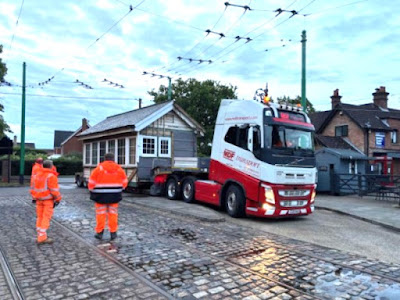Another Big Surprise
Many moons ago, fbb sallied forth with his boss from Southern Vectis in an ultimately failed attempt to get the bus industry to save money and adopt Xephos. Being astoundingly risk averse, the industry adopted Traveline which costs a fortune and isn't very good!David Leeder was then something very important at First Group, possibly boss of the bus business thereof. The visit failed totally but an astute fbb spotted some "body language" and actual language. As expected (by fbb at least) David left First a few weeks (months?) later to work in Germany.
He later returned to become a consultant.
In a reminder of the rather unkind epithet, "those who can, do; those who cannot, become teachers", fbb in cynical mood, postulates an alternative. In the bus business, those who can, do; those who cannot, become consultants!".
So be it!The above article refers to some prognostications from Mr Leeder wearing his consultancy hat.Just to re-iterate. Our David has calculated that the Bee Network has cost £200 million to set up and will be costing £200 million a year to run, that is £100 million a year more than the good old Greater Manchester PTE cost.
These figures look a little too "neat" to be reliable, but, in principle, we the tax payer will be paying a very high price for Andy Burnham's yellow buses and trams.
And remember, dear reader, that apart from yellow paint and a few tinkerings with ticket prices, nothing has changed. The Bee Network is almost exactly the same as its PTE predecessor.
Frightening isn't it?
Equally Frightening But SmallerWhat may well be a cause for concern is that most bus watchers were very well aware of the route that Hulleys was taking ...... so why wasn't something done earlier?
Equally Frightening But SmallerWhat may well be a cause for concern is that most bus watchers were very well aware of the route that Hulleys was taking ...... so why wasn't something done earlier?
Surely the financially astut0 would have seen the signals?
And Different Signals
This is Oulton Broad station on the railway line west from Lowestoft.The "flavour" of the line can be gleaned from the preponderance of in-track vegetation! Here is the station's signal box, once controlling semaphore signals and the level crossing.With the commissioning of new signalling on the route and the half-barrierisation of the crossing, the box became redundant. So it had to go!So, unceremoniously under cover of darkness, it went! It was sawn from its relay room base and loaded by crane on a low-loader and off it trundled.
It eventually arrived at the East Anglia Transport Museum at Carlton Colville ...... where it will be displayed.The museum looks like a spiffing place to visit.More signal boxes in due course!
And, Talking of East Anglia
An old Isle of Wight church chum, name of Vic, kindly sends fbb copies of "Trackside" magazine a lavish glossy periodical for the lovers of Railway Preservation. The photography is sumptuous.A recent edition has an article about London Underground's preserved 1938 four car unit. But this picture is puzzling.By the look of the crowds on the platform, it is a heritage run. But where? The platform sign says ...... District and Piccadilly Lines! The other track, not in fbb's cropped image, looks almost disused.
So where are we and/or when are we? fbb cannot work it out. Answers to
fbb@xephos.com
But this reminder, that 1938 stock still exists, take fbb to a model of a similar four car unit,But this is not OO as for the EFE set ...... the above version fitted with lights and sound - and expensive! The Rapido N gauge model is almost one quarter of the size.Quite how you get a motor and gearing into this AND an interior is something of mystery. fbb is sure somebody will fit it up with lights and sound.
It Is Hot Down The Tube!Great!
Next Variety blog : Sunday 22 June





.jpg)

.jpg)












It would be interesting to see an itemised breakdown of the “costs” of setting up franchised networks and the continuing costs of running them, alongside the costs the relevant authorities would have incurred to maintain the current systems.
ReplyDeleteThe 1938 stock is at Acton Town, westbound.
ReplyDeleteYou beat me to it!
DeleteWhat Mr Leeder fails to mention is that passenger numbers on Bee Network buses have increased, so that's more revenue to offset the costs for a start. TfGM has also identified cost savings through having control of the network, as opposed to having to compensate for inadequacies in commercially-provided services.
ReplyDeleteAnd there is money, namely the City Region Sustainable Transport Settlement. This is investment funding which, amongst other things, is funding new zero-emission buses, with an ambitious target of a 100% zero-emission fleet by end 2030. This means manufacturing jobs for British companies - and tax revenues from the people they employ.
Mr Leeder must surely be aware of all this as a transport consultant. Maybe it just doesn't suit his narrative.
The net cost of providing the network in the 2925-26 budget is £226.5m. The net cost previously was roughly £25m for tendered services and almost £75m for concessionary fares. And the passenger growth figures quoted are less than the national average. So given there have been almost no frequency increases, it does indeed cost double to stand still.
Delete... 'identified cost savings' isn't quite the same thing as 'achieving cost savings' ... and 'City Region Sustainable Transport Settlement' (i.e Government money) is subsidy ... and 'manufacturing jobs for British companies' ... maybe, or maybe for Chinese companies.
ReplyDeleteSubsidy - or investment? Whatever you want to call it, every £1 spent on supporting bus services can potentially generate over £4 of benefit to the wider economy. And in the case of Greater Manchester, most of the new buses for Bee Network have been built in the UK.
DeleteWhat we really need is model Tube stock with working doors ...!
ReplyDelete